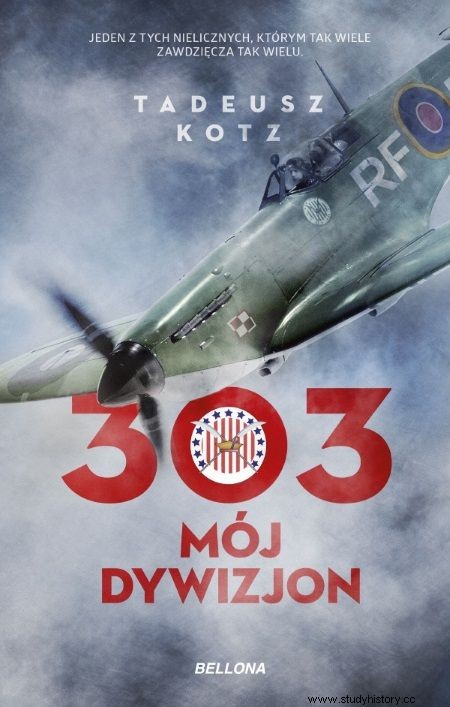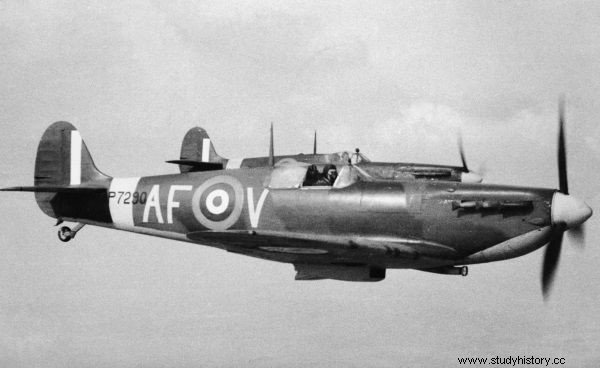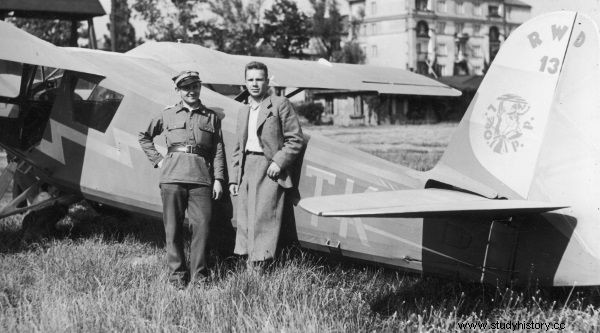After the outbreak of the war, this boy from the Podlasie village did not waste any time - he went into battle, sitting at the controls of a fighter plane. First, he fought with the Germans over Poland, and then over the whole of Europe. Finally, he became the commander of the most famous Polish squadron in history.
When Tadeusz Kotz was shot down over northern France on February 3, 1943, he did not know if he would return to the fight again. Despite various adversities, he managed to break through the Pyrenees and reach Gibraltar, from where he was transported to England. In the meantime, friends have long had time to put a cross on him. They were so convinced of his death that when he checked back to the base ... people passed him without greeting him, convinced that they saw a ghost.
After returning to the British Isles, the current captain Kotz, in recognition of his merits, was promoted to the rank of major. The changes did not end with the higher charge. On November 20, 1943, the pilot was appointed commander of the most famous Polish formation from World War II:303 Fighter Squadron of Warsaw. Tadeusz Kościuszko, called 303 Squadron for short. It was by no means a warm job.
As Kotz himself recalls in his book "303. My Squadron ” although it was in his hands to be in command, he did not shy away from fighting. Especially when the order to depart came under unfavorable conditions.
Once, from the 11th Aviation Group, an order came to assign two spitfires to fly at low altitude towards Paris. The pilots were tasked with firing at targets on the ground, which could include, for example, airports.

303 Squadron pilots during Marian C. Cooper's visit (in a suit). who commanded the 7th squadron in the Polish-Bolshevik war.
Years later, Kotz recalled:
In these cases, I took a young and unmarried aviator, and the second was me, so it doesn't look like I'm scared myself. […] We were about twenty kilometers from Le Havre when suddenly we fell into a terrible fire from the ground. Mijakowski managed to shout on the radio:
- Got it!
[…] we're five kilometers out in the sea, and suddenly - oh, God! - Mijakowski's spitfire slowly lowered and hit the water, disappearing in the stormy waves. I did two laps over the accident site. The lieutenant was killed by an airman. Hello his memory!
For Tadeusz Kotz, however, the mission is not over yet. He was already heading towards the base when suddenly British AA defenses opened fire on him. Squadron commander's Spitfire 303 was confused with a German plane. He was close, and he would have shared the fate of his colleague.

Memoirs of Tadeusz Kotz "303. My Division " have just been released by Bellona
The unit under Kotz's command was constantly at the center of the events. When the order came, the pilots carried it out regardless of the weather, the enemy traffic and no murmurs, believing that each mission brought them closer to free Poland. The Arnhem Operation seemed to be the next step on this path.
Tadeusz Kotz commanded the Kościuszko Squadron also on September 17, 1944, when the Allies launched the "Market Garden", the largest operation involving airborne troops. While the soldiers were preparing for the landing, they were covered from the air by a whole cloud of planes. The commander was in the air with his pilots at 2 am over the English zone. As he recalled years later:
We were not very busy:on our side the air advantage was so great that German planes were rare. After an hour of patrol, other squadrons changed us. Our squadron was still on patrol at eight in the morning and for the third time at two in the afternoon. The second shift at eight o'clock escorted our paratroopers against attacks from above. As far as the eye could see, hundreds of yellow and red parachutes landed along the shore in enemy territory.

Spitfire (photo:public domain)
An inspiring picture stretched out from above, but a murderous fight continued below. Fire flared incessantly on both sides. Ultimately, the landing failed due to the wrong place to carry it out. As emphasized in his memoirs by Kotz Although some authors blame the failure on the weather, that day he and his pilots flew in perfect conditions, and only here and there were little clouds.
When 303 Squadron completed its next turn of escorting soldiers, the pilots returned to the English shore. At the height of the island of Walcheren, the Germans opened strong anti-aircraft artillery fire on them. Polish airmen managed to get out of this "warm welcome" unscathed. Also Tadeusz Kotz believed that the worst was behind them when suddenly the engine of his plane stopped.
The Spitfire's motor choked on black smoke three times and stopped working. As he noted in the book "303. My Division " :
There was no other option:I handed over command to my deputy Captain Bruno Kudrewicz, and I turned back to land myself. The same island of Walcheren again, only this time, losing altitude, I plan lower and lower on a glider. "Just to get to the land," I think, trying to start the engine with the throttle.

Pilot Mieczysław Urban and instructor Leon Powsiński (from Areoklub Warszawski). (photo:public domain)
The hell of anti-aircraft artillery fire broke out around him again. The Germans tried at all costs to knock down the pilot descending lower and lower. Meanwhile, Kotz, being at an altitude of twenty meters, was already looking for a place to land. He didn't even extend the undercarriage. He only adjusted the straps. He was getting ready to hit the ground when the plane engine suddenly… decided to surprise.
The overjoyed Polish pilot set off at full speed up. Instead of risking a third encounter with enemy artillery near Walcheren, he chose a course towards Belgium, where our other airmen were stationed in Gent. His machine was taken care of on the spot.
It turned out that the Spitfire was covered in black sooty engine oil that completely obscured the markings. At that time, the 303 Squadron commander met his friend from before the war. Together with Mieczysław Urban, who broke records in gliding flights in the 1930s, Kotz attended a military school. A friend celebrated the unexpected meeting and the great happiness of the 303 Squadron commander by handing him a bottle of French wine.
Kotz put it on a plane refueled by the Polish service, took off and soon was at his own base in southern England. Colleagues expected rather sad news. When it turned out that the commander came back safe and sound, and in addition with French champagne, they had a lot of fun. On September 25, Kotz handed over the command of the squadron.
Source:
- Memoirs of Tadeusz Kotz "303. My Division ”, which have just been released by the Bellona publishing house.
Read the memoirs of the 303 Squadron commander:

